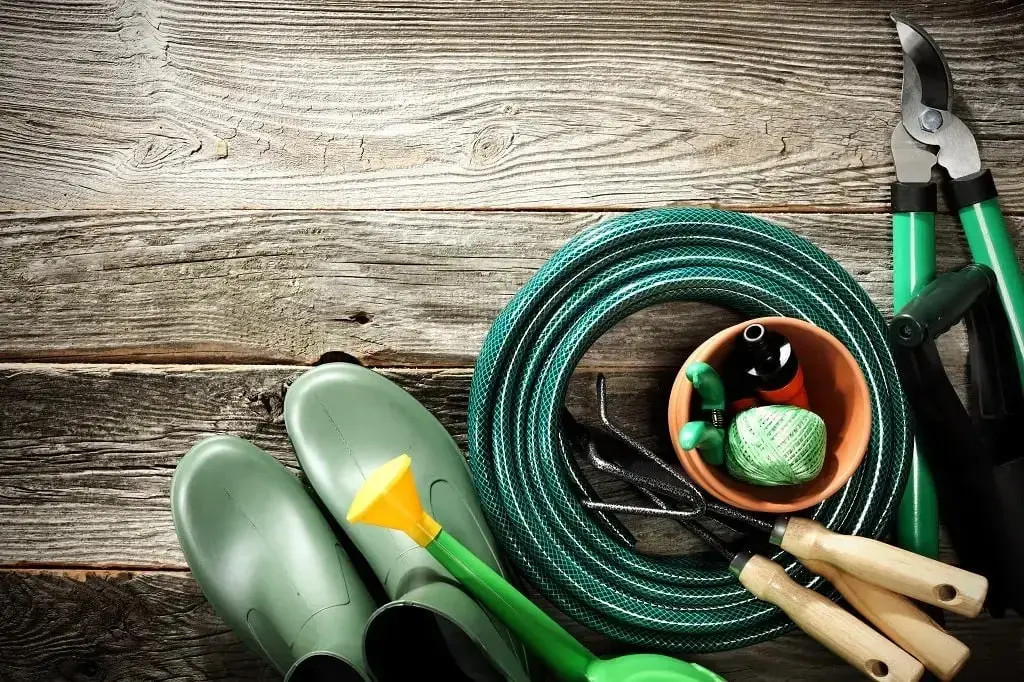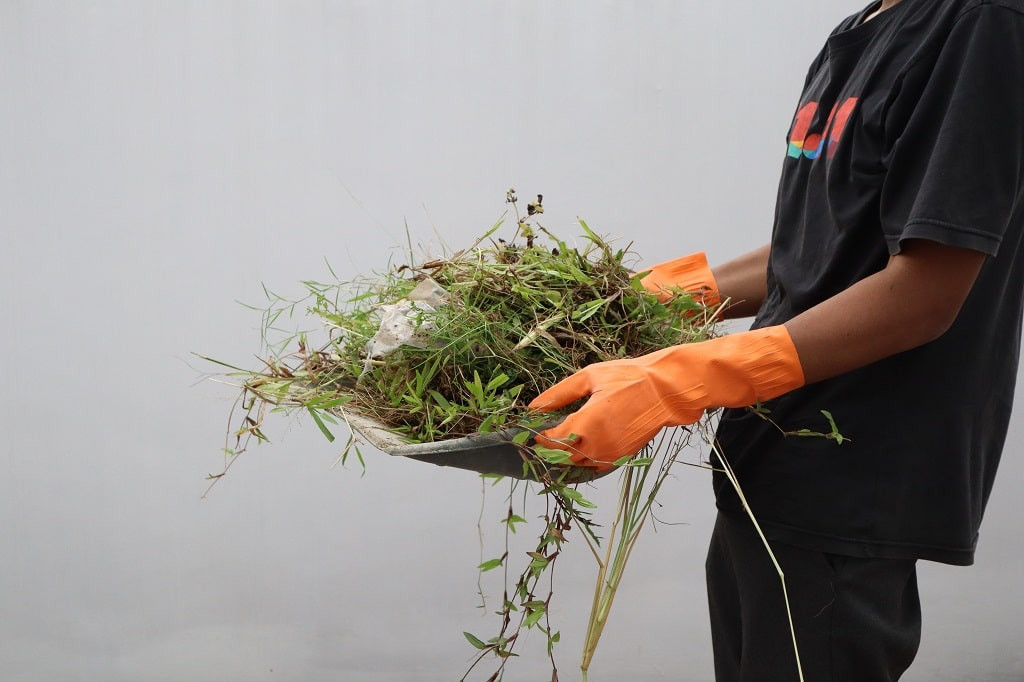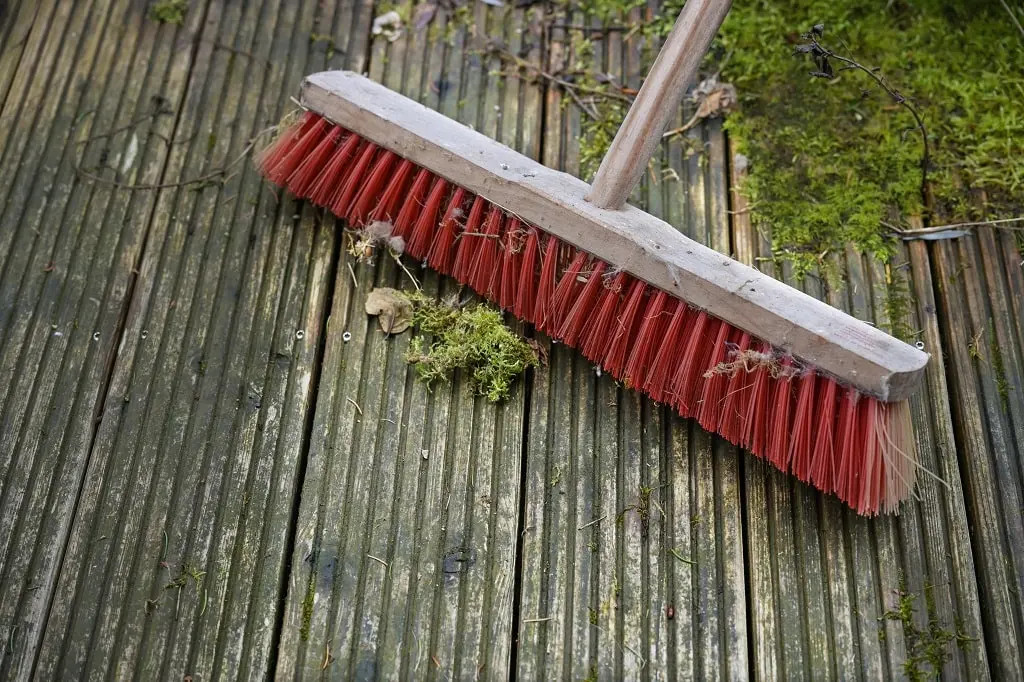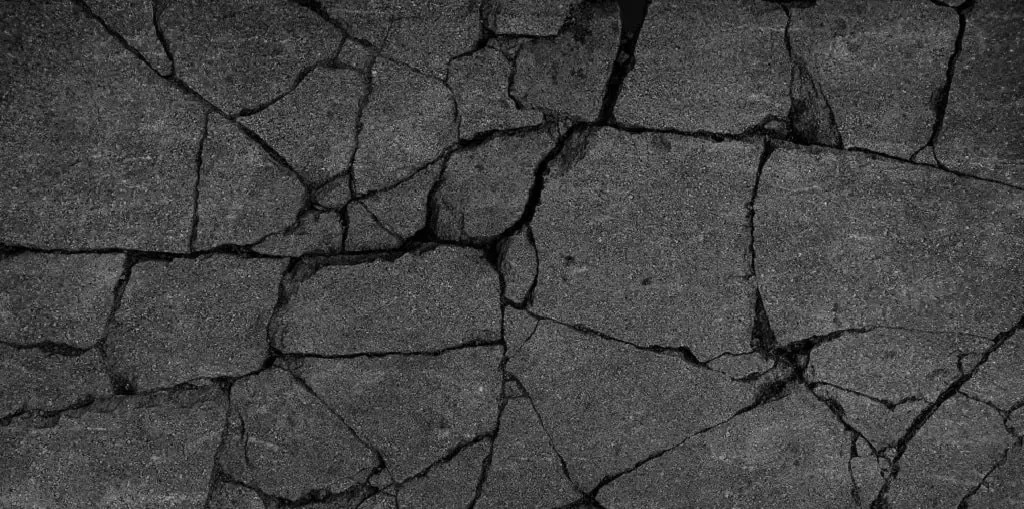River rocks, with their smooth, natural beauty, can elevate the aesthetic of any landscape. But how do you keep them looking their best? This comprehensive guide from rockscapes.net will walk you through the process of cleaning dirty river rock, ensuring your outdoor space remains stunning. Let’s dive into the world of river rock cleaning and discover how to maintain their pristine appearance.
1. Why Is Cleaning River Rock Important?
River rock isn’t just visually appealing; it also plays a crucial role in drainage and preventing weed growth. Cleaning river rock is essential for maintaining the beauty and functionality of your landscape.
1.1 Enhancing Aesthetic Appeal
Clean river rocks significantly enhance the aesthetic appeal of your outdoor space. Removing dirt, algae, and debris reveals the natural colors and textures of the stones, creating a more inviting and visually pleasing environment.
1.2 Preventing Weed Growth
Accumulated dirt and organic matter in river rock beds provide a breeding ground for weeds. Regular cleaning removes these materials, inhibiting weed growth and reducing the need for herbicides. According to research from the University of Arizona’s College of Agriculture and Life Sciences, maintaining weed-free rock beds can significantly improve the overall health and appearance of your landscape.
1.3 Improving Drainage
Over time, river rock can become clogged with dirt and debris, impeding drainage and leading to water buildup. Cleaning the rocks restores proper drainage, preventing water damage and ensuring healthy plant growth. Poor drainage can lead to root rot and other plant diseases, as noted in studies by the Agricultural Research Service (ARS) of the USDA.
1.4 Prolonging Lifespan
Regular cleaning extends the lifespan of your river rock by preventing the accumulation of harmful substances that can cause erosion and discoloration. This simple maintenance task can save you money on costly replacements.
2. What Are The Key Considerations Before Cleaning River Rock?
Before diving into the cleaning process, consider the following factors to ensure the best results and protect your river rocks.
2.1 Assess the Type of River Rock
Different types of river rock require different cleaning approaches. For instance, delicate stones may not withstand the force of a pressure washer. Understanding the composition and durability of your rocks will help you choose the appropriate cleaning method.
2.2 Evaluate the Level of Dirt and Staining
Determine the extent of dirt, algae, and staining on your river rocks. This assessment will help you select the right cleaning solutions and tools. Lightly soiled rocks may only require a simple rinse, while heavily stained rocks may need more intensive scrubbing.
2.3 Consider Environmental Impact
Choose eco-friendly cleaning solutions that won’t harm your plants, soil, or local waterways. Avoid harsh chemicals and opt for biodegradable detergents or natural alternatives like vinegar and baking soda. The Environmental Protection Agency (EPA) provides guidelines for selecting safer cleaning products.
2.4 Plan for Proper Drainage
Ensure that the area where you’re cleaning the river rocks has adequate drainage to prevent water buildup. If necessary, clear drainage paths or create temporary channels to direct water away from sensitive areas.
2.5 Protect Yourself
Wear appropriate protective gear, such as gloves, safety goggles, and a mask, to protect yourself from dirt, debris, and cleaning solutions. This is especially important when using pressure washers or chemical cleaners.
3. What Tools And Materials Will I Need To Clean River Rock?
Gathering the right tools and materials is essential for efficient and effective river rock cleaning.
3.1 Essential Tools
- Garden Hose: A garden hose with an adjustable nozzle is necessary for rinsing the rocks and removing loose dirt.
- Pressure Washer (Optional): A pressure washer can be used for heavily soiled rocks, but exercise caution to avoid damage.
- Stiff-Bristle Brush: A stiff-bristle brush is ideal for scrubbing the rocks and removing stubborn dirt and algae.
- Bucket: A bucket is needed for mixing cleaning solutions.
- Gloves: Gloves protect your hands from dirt and cleaning solutions.
- Safety Goggles: Safety goggles shield your eyes from splashes and debris.
- Rake or Leaf Blower: A rake or leaf blower helps remove leaves and debris from the area.
- Small Brush or Toothbrush: A small brush or toothbrush is useful for cleaning crevices and hard-to-reach areas.
3.2 Cleaning Solutions
- Mild Dish Detergent: A mild dish detergent is a gentle and effective cleaning solution for most river rocks.
- White Vinegar: White vinegar is a natural cleaner that can help remove stains and algae.
- Baking Soda: Baking soda can be used to scrub away stubborn dirt and grime.
- Bleach (Optional): Bleach can be used for heavily stained white rocks, but use it sparingly and with caution.
3.3 Additional Materials
- Tarp: A tarp can be used to protect surrounding plants and surfaces from dirt and cleaning solutions.
- Sealant (Optional): A sealant can be applied after cleaning to protect the rocks and make future cleaning easier.
4. What Are The Step-By-Step Instructions For Cleaning River Rock?
Follow these detailed steps to clean your river rock effectively and safely.
4.1 Preparing The Area
 how to clean landscape rocks
how to clean landscape rocks
4.2 Removing Debris
 clean landscape rock
clean landscape rock
4.3 Rinsing The River Rock
Using a garden hose, rinse the river rocks to remove any loose dirt and grime. Start at the top of the area and work your way down, allowing the water to flow away from the clean sections. If you’re using a pressure washer, use a wide nozzle and keep a safe distance to avoid damaging the rocks.
4.4 Scrubbing The Rocks
 cleaning rocks
cleaning rocks
4.5 Cleaning Crevices
 how to clean dirty landscape rocks
how to clean dirty landscape rocks
4.6 Rinsing Again
After scrubbing the rocks, rinse them thoroughly with the garden hose to remove any remaining dirt and cleaning solution. Ensure that all traces of detergent or cleaning agents are gone to prevent any harm to plants or animals.
4.7 Drying The River Rock
Allow the river rocks to air dry completely. This may take several hours or even a full day, depending on the weather conditions. If you need to speed up the drying process, you can use a leaf blower or a dry towel to remove excess moisture.
5. How To Clean White River Rock
White river rock requires special attention to maintain its bright and polished appearance. Here’s how to clean white landscape stones effectively.
5.1 Pre-Cleaning Steps
- Remove any debris or obstacles near the white river stones, such as furniture or garden decorations.
- Gather essential tools, including a garden hose or pressure washer, a stiff-bristle brush, a bucket with a mild detergent solution, gloves, and safety goggles.
5.2 Removing Loose Debris
- Use a rake or leaf blower to clear away leaves, twigs, and other loose debris from the white river stones.
5.3 Rinsing The Stones
- Gently rinse the white river stones using a garden hose or pressure washer, starting from the top and working your way down.
5.4 Applying Cleaning Solution
- Mix a gentle detergent with water in a bucket to create a mild cleaning solution. Dip a stiff-bristle brush into the solution and scrub the white river stones.
5.5 Addressing Stubborn Stains
- For stubborn stains, mix one part bleach with four parts water in a separate bucket. Carefully apply the bleach solution to the stained areas using the stiff-bristle brush. Let the solution sit for a few minutes before rinsing thoroughly. Exercise caution when using bleach to avoid damaging surrounding plants or surfaces.
5.6 Final Rinse And Dry
- After scrubbing the stones, rinse them again with the garden hose or pressure washer to remove any remaining dirt and cleaning solution. Allow the white river stones to air dry completely to prevent water spots and ensure a polished look.
6. How To Maintain River Rock Landscaping
Maintaining river rock landscaping involves regular upkeep to prevent dirt and debris buildup.
6.1 Regular Maintenance
- Regular maintenance is key to keeping debris at bay. Make it a habit to regularly inspect and clean your river rock.
6.2 Investing In Garden Tools
- A good pair of gloves, a rake, and a leaf blower can make the task of cleaning debris from river rock much easier and faster.
6.3 Using Weed Barriers
- Consider using a weed barrier or landscape fabric underneath the river rock to prevent weed growth.
6.4 Regular Raking And Sweeping
- Use a rake to remove larger debris and a broom or leaf blower to sweep away smaller bits of debris.
6.5 Applying Safe Weed Killer
- If weeds appear, use a safe weed killer to prevent them from taking over your river rock.
6.6 Installing Gutter Guards
- Install gutter guards to prevent leaves and other debris from falling into the river rock from nearby trees or shrubs.
6.7 Using Organic Mulch
- Consider using organic mulch around your plants to prevent weed growth and keep the river rock clean.
7. What Are The Benefits Of Using River Rock In Landscaping?
River rock offers numerous benefits when used in landscaping, making it a popular choice for homeowners and landscape designers alike.
7.1 Aesthetic Appeal
River rock adds a natural and elegant touch to any outdoor space. Its smooth, rounded surface and varied colors create a visually appealing texture that complements various landscaping styles.
7.2 Low Maintenance
Compared to grass or other ground covers, river rock requires minimal maintenance. It doesn’t need mowing, fertilizing, or regular watering, saving you time and resources.
7.3 Weed Control
River rock acts as a natural weed barrier, preventing sunlight from reaching the soil and inhibiting weed growth. This reduces the need for herbicides and manual weeding.
7.4 Erosion Control
River rock helps prevent soil erosion by providing a protective layer that stabilizes the ground and reduces the impact of rain and wind. This is particularly useful on slopes or areas prone to erosion.
7.5 Drainage Improvement
River rock improves drainage by allowing water to flow freely through the stones, preventing water buildup and promoting healthy plant growth. This is especially beneficial in areas with poor soil drainage.
7.6 Versatility
River rock can be used in a variety of landscaping applications, including garden beds, pathways, dry creek beds, and decorative features. Its versatility allows you to create unique and personalized outdoor spaces.
8. What Are Some Common Mistakes To Avoid When Cleaning River Rock?
Avoiding common mistakes can help you clean your river rock effectively and prevent damage.
8.1 Using Harsh Chemicals
Avoid using harsh chemicals like bleach or strong detergents, as they can damage the rocks and harm surrounding plants and animals. Opt for gentle, eco-friendly cleaning solutions.
8.2 Overusing A Pressure Washer
Be cautious when using a pressure washer, as excessive pressure can erode the rocks or dislodge them from their position. Use a wide nozzle and keep a safe distance to prevent damage.
8.3 Neglecting Safety Precautions
Always wear gloves, safety goggles, and a mask when cleaning river rock, especially when using cleaning solutions or a pressure washer. This will protect you from potential hazards.
8.4 Ignoring Drainage
Ensure that the area where you’re cleaning the river rock has adequate drainage to prevent water buildup. Standing water can promote algae growth and damage the rocks.
8.5 Skipping Regular Maintenance
Don’t wait until your river rock is heavily soiled before cleaning it. Regular maintenance, such as removing debris and rinsing the rocks, will prevent the buildup of dirt and make cleaning easier.
9. How Often Should You Clean River Rock?
The frequency of cleaning river rock depends on several factors, including the location, climate, and level of debris accumulation.
9.1 General Guidelines
- Lightly Soiled Areas: Clean river rock every 3-6 months.
- Heavily Soiled Areas: Clean river rock every 1-3 months.
- Areas with Heavy Debris: Clean river rock as needed, especially after storms or periods of heavy leaf fall.
9.2 Factors to Consider
- Location: River rock in areas with heavy tree cover or frequent rain may require more frequent cleaning.
- Climate: Humid climates promote algae growth, necessitating more regular cleaning.
- Usage: River rock in high-traffic areas may accumulate dirt and debris more quickly, requiring more frequent cleaning.
9.3 Signs It’s Time to Clean
- Visible dirt, algae, or stains on the rocks
- Foul odors emanating from the river rock bed
- Poor drainage or water buildup
- Excessive weed growth
10. What Are Some Creative Ways To Use River Rock In Landscaping?
River rock can be used in a variety of creative ways to enhance your landscape.
10.1 Garden Beds
Use river rock as a mulch alternative in garden beds to suppress weeds, retain moisture, and add visual appeal.
10.2 Pathways
Create pathways using river rock to add a natural and rustic touch to your garden.
10.3 Dry Creek Beds
Design a dry creek bed using river rock to mimic the look of a natural stream and improve drainage.
10.4 Decorative Features
Use river rock to create decorative features such as rock gardens, borders, and focal points in your landscape.
10.5 Water Features
Incorporate river rock into water features such as ponds and fountains to add a natural and soothing element.
10.6 Erosion Control
Use river rock to stabilize slopes and prevent soil erosion in areas prone to runoff.
Maintaining clean and beautiful river rock is a rewarding task that enhances the overall appeal of your outdoor space. By following these tips and tricks, you can keep your river rock looking its best for years to come.
For more inspiration, detailed information on different types of stones, and expert advice on landscaping projects, visit rockscapes.net today. Let us help you transform your outdoor space into a stunning oasis with our premium rock and stone solutions. Contact us at 1151 S Forest Ave, Tempe, AZ 85281, United States, or call +1 (480) 965-9011. Explore our virtual natural stone catalog at rockscapes.net and discover the endless possibilities for your landscape.
Frequently Asked Questions (FAQs)
-
How do I clean river rock without removing it from the landscape?
- You can clean river rock in place by removing debris, rinsing with a hose, scrubbing with a brush and mild detergent, and rinsing again.
-
What is the best way to remove algae from river rock?
- Scrub the rocks with a mixture of water and white vinegar or use a commercial algae remover, following the product instructions carefully.
-
Can I use bleach to clean river rock?
- Yes, but use bleach sparingly and dilute it with water. Rinse thoroughly to avoid harming plants or animals.
-
How do I prevent weeds from growing in my river rock?
- Use a weed barrier fabric underneath the rocks and apply a safe weed killer as needed.
-
How often should I clean my river rock?
- Clean river rock every 3-6 months or more often if it’s in a heavily soiled area.
-
What is the best tool for cleaning large areas of river rock?
- A pressure washer can be effective for large areas, but use it with caution to avoid damaging the rocks.
-
Can I use a leaf blower to clean river rock?
- Yes, a leaf blower can help remove loose debris and leaves from the surface of the river rock.
-
Is it safe to use dish soap to clean river rock?
- Yes, a mild dish detergent is safe and effective for cleaning most river rocks.
-
How do I clean white river rock to keep it looking bright?
- Use a bleach solution for stubborn stains, but be sure to rinse thoroughly and avoid contact with plants and animals.
-
Should I seal my river rock after cleaning it?
- Sealing the rocks can help prevent the buildup of dirt and algae, but it’s not necessary. Use a sealant specifically designed for stone surfaces.